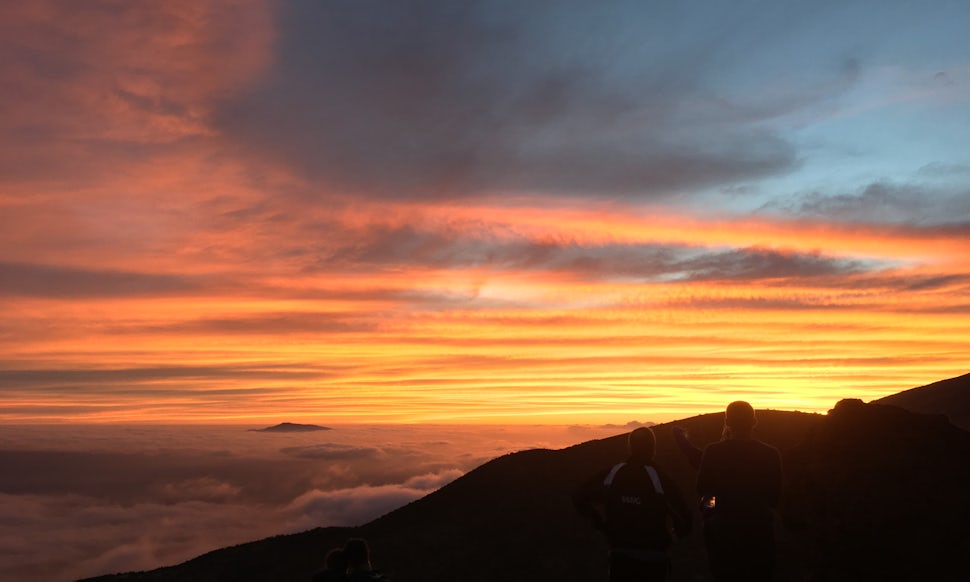Catching the Sunset at Mauna Kea Visitor Center
If you're ever lucky enough to find yourself on the Big Island, this volcanic mountain should hold a spot right on top of your list.

Mauna Kea is the highest point on the Big Island of Hawai’i, and the sunset and star gazing at its visitor center are a must for those visiting.
It’s the perfect spot.
9,000ft above sea level on an island with little light pollution keeps the stars bright and puts you above the clouds, but not so high as the stars become blurry to the human eye.
(the blurriness comes from thinner air at high elevations).
Our drive up from the coast to the visitor was amazing.
We were sent up the valley between Mauna Kea and Mauna Loa, cutting through stunning plant life and black lava fields, then up a winding mountain road where we broke through the first layer of cloud coverage.
Be sure to fill up on gas before you leave though.
The nearest gas station is 35 miles away from the visitor center, and fuel is not available for purchase at Mauna Kea.
Sunset
We took a small hike up for a good view of the sun while it was setting.
You might feel the immediate altitude jump from the last time you got in your car, but we went with several young kids and they made it up and back fine.




From atop of the hill you have a gorgeous view of Mauna Loa, the valley below, and whatever clouds are filling the island.
We spent about an hour watching the multiple transitions of bright colors this sunset underwent.









Star Gazing
Conditions for star gazing were rather bad for us. It was a cloudy night with a very bright moon, but we still enjoyed it.
It was a beautiful night, and we were lucky enough to see a rare phenomenon. A shooting star left a bright red line behind it, lasting for a long time. The staff running the event said it was their first time seeing it as well.
I can only imagine the splendor of a clear day out there. From what I’ve been told it is absolutely stunning.
Public star gazing events are held on Tuesday, Wednesday, Friday, and Saturday evenings from 7 pm – 10 pm weather permitting.
It’s totally free, but parking is limited.
The parking lot can fill 115 spots and it’s first come first serve. Once it’s filled up cars will be turned away. Luckily we didn’t have a problem during our stay.
Telescopes are set up for viewing at 7 pm, and as soon as it’s dark enough a tour of the constellations will begin. For us, it was 8:30 pm.
The guided tour was my major draw for this event.
Staff use a laser pointer to teach you about all the constellations out in the sky. It’s more than just traditional western constellations, however. During our tour of the stars, we learned a lot about Polynesian constellations, including Maui’s Hook.
Privately owned telescopes are not allowed during public stargazing events, but they are welcome all other nights (Sunday, Monday, Thursday).
Check with the visitor information station staff before setting up your telescope to receive a safety briefing.
Temperatures can reach near freezing some nights at the visitor center. Be sure to dress warm, and check the weather.
I didn’t get any shots of the stars since I only have an iPhone, but here’s a little pic of the moon for night time vibes.

For more information on the visitor center follow this link to their website.
Geography of Mauna Kea
Mauna Kea was formed by the same hotspot that created the entire Hawaiian Archipelago and the french frigate shoals (gotta make sure I spelled that right too).
Mauna Kea is one of six volcanoes that formed the Big Island. It reaches an altitude of 13,796 ft above sea level.
However, more than half of the mountain lays bellow the ocean’s surface. This adds 18,900ft to Mauna Kea’s height (32,696ft) making it the tallest mountain on Earth – 3,661 ft taller than Mount Everest.
With all that height the mountain provides a rich diversity of life.
Above sea level, Mauna Kea is home to stone deserts, shrublands, alpine woodlands, and tropical forests.
Most of Mauna Kea’s life below the water lies between 0 and 1,189ft. These are the sunlight and twilight realms.
Deeper than 3,900ft lie the midnight zone and abyss. These environments are surrounded by high water pressure, darkness, cold temperatures, and a thing supply of food.
Species on this half of Mauna Kea must have extreme adaptations to survive here.
For more information on the geography of Mauna Kea follow this link to Nat Geo.



----
If by the end of this you're looking for something a bit more strenuous, I definitely recommend you check out an adventure I published earlier this year on hiking all the way up Mauna Kea. It's the second highest peak I've ever hiked, and sleeping at sea level the night before made it my largest single day elevation gain.
---
(This post was originally published on camandtheoutdoors.com).
We want to acknowledge and thank the past, present, and future generations of all Native Nations and Indigenous Peoples whose ancestral lands we travel, explore, and play on. Always practice Leave No Trace ethics on your adventures and follow local regulations. Please explore responsibly!
Do you love the outdoors?
Yep, us too. That's why we send you the best local adventures, stories, and expert advice, right to your inbox.



